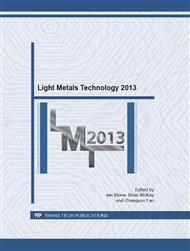p.112
p.117
p.123
p.130
p.135
p.140
p.145
p.150
p.155
The Effect of Superheating and Cooling Rate on Primary Precipitation of Si in Hypereutectic Al-Si Alloys
Abstract:
The effect of superheating and cooling rate on primary precipitation of Si was studied in hypereutectic Al-Si alloys. Alloys with compositions of 15, 18 and 20 wt% Si were solidified in unidirectional solidification equipment from different temperatures and drawing speeds. The fraction of primary silicon was measured over a certain distance of the sample in the steady state region. Results show a large variation in primary silicon fraction along the sample length and with varying cooling rate. The fraction of primary silicon and primary aluminium around silicon increases with increasing superheat. These fractions decrease with increasing cooling rate and the structure changes to a more refined dendritic-like primary silicon. Different morphologies of Si and their transformation during solidification can be seen over the sample length. An analysis of the quenched solidification front shows the possibility of strong convection ahead of the solidification front. The convection can be caused by density variation in the liquid due to the cluster structure of the melt which changes the microstructure.
Info:
Periodical:
Pages:
135-139
Citation:
Online since:
July 2013
Authors:
Price:
Сopyright:
© 2013 Trans Tech Publications Ltd. All Rights Reserved
Share:
Citation:


